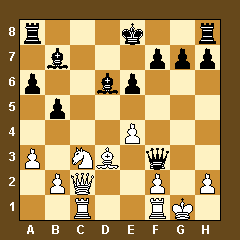|
 22.Qe2
Qxe2 Black has faith in his pawn and his bishops. ..Qf4 was
more aggressive, but if you have a concrete, simple advantage, there
is no need to risk complications you're not sure about. 22.Qe2
Qxe2 Black has faith in his pawn and his bishops. ..Qf4 was
more aggressive, but if you have a concrete, simple advantage, there
is no need to risk complications you're not sure about.
Any good Ninja knows it's not the style of the kill,
it's the kill. 23.Nxe2 Ke7 Smack yourself in the head of
you wanted to castle here. It's safe for the king and it's much
better placed for the endgame now than on g8.
24.f4 Rac8 25.Kf2 Rhd8 26.Rxc8 Rxc8 27.Ke3 Bc5+
28.Kd2 Rd8 29.Kc2 Another advantage for Black: White has three
pawn 'islands' and compared to two for Black. This makes the white
pawns much harder to defend, especially that stray puppy on h2.
29...g6 30.b4 Be3 31.Rf3 Rc8+ 32.Kb3 Bd2 33.Rh3
h5 34.Bc2 Rc4 35.Rd3 Be1 Black might be taking it a little TOO
easy here. 35...Bxf4 looks like a simpler path to victory. On the
other hand, Vera was probably in love with his dominating position,
and who can blame him?
[ 35...Bxf4 36.Nxf4 Bxe4 37.Nh3 ( 37.Rd2
Bxc2+ 38.Rxc2 Rxf4) 37...Bxd3 38.Bxd3 Rh4 39.Bf1 Black shouldn't
have any trouble winning with his mighty line of pawns. But there
is at least a possibility of making a mistake here, with the queenside
pawns being vulnerable to the white bishop. Black's choice to play
35..Be1 was a no-risk option. ]
36.Rd1 Bf2 This bishop continues to
limit the knight's moves. That's one of the biggest advantages of
a bishop over a knight in an endgame. 37.Bd3 Rc7 38.Ra1 f5 39.exf5
Bd5+ 40.Kb2 gxf5 41.a4 Good defensive strategy. Rustemov wants
to liquidate all the pawns on the queenside. This would make it
easier to defend his other pawns.
The long-range bishops can torture him on
both sides of the board at the same time. The knight will gain power
if it only has to work on one side of the board. 41...Bh4 42.Ra3
To avoid the ..Bf6+ x-ray attack. 42...Bf6+ 43.Kb1 Bc4 That's
the bishop Black wants to exchange. He absolutely wants to avoid
ending up with bishops of opposite colors, which would give White
very good chances to draw. 44.Nc1 Bxd3+ 45.Nxd3 Rc3 46.Rxc3 Bxc3
 Trading
down to Black's main advantages. An extra pawn and bishop vs knight
in an endgame with pawns all over the board. Even worse, white's
pawns are stuck on the same color as Black's bishop, making them
easy targets. 47.Kc2 Bd4 48.axb5 axb5 49.Ne1 Be3 50.Ng2 Bf2 51.h3
Kd6 52.Kd2 Kd5 53.Ke2 Ba7 54.Kd3 Bb6 55.Ne1 Bc7 56.Ng2 Kc6 57.Kd4
Bd6 58.Kc3 Kd5 Trading
down to Black's main advantages. An extra pawn and bishop vs knight
in an endgame with pawns all over the board. Even worse, white's
pawns are stuck on the same color as Black's bishop, making them
easy targets. 47.Kc2 Bd4 48.axb5 axb5 49.Ne1 Be3 50.Ng2 Bf2 51.h3
Kd6 52.Kd2 Kd5 53.Ke2 Ba7 54.Kd3 Bb6 55.Ne1 Bc7 56.Ng2 Kc6 57.Kd4
Bd6 58.Kc3 Kd5
With excellent "tempo play" Black has pushed the
white king away. The bishop attacks b4 and f4, so the knight is
frozen. Now the black king comes in for the kill. 59.Ne3+ Ke4
60.Nc2 White is practical. He can't protect the f-pawn so at
least he will grab the b5 pawn and try to create chances with a
passed b-pawn. 60...Kxf4 61.Na3 Kg3 62.Nxb5 Be5+
|